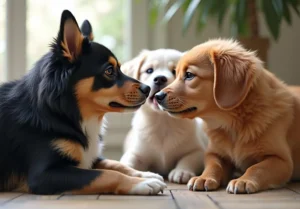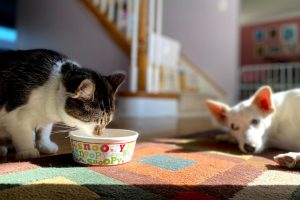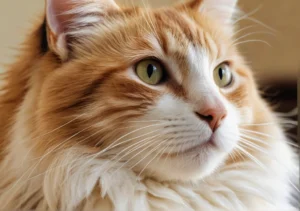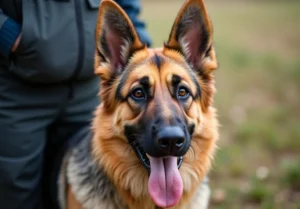Cats and dogs are known to nibble on grass from time to time, leaving pet owners puzzled as to why their furry friends indulge in this behavior.
Both cats and dogs eat grass primarily to aid in digestion and provide essential nutrients that may be missing from their diet.
Reasons Behind Grass Eating
Curiosity may have killed the cat, but cats and dogs nibbling on grass isn’t a sign of impending doom. While pets may not be able to directly communicate their motives, there are several reasons why they engage in this seemingly strange behavior.
One common belief is that eating grass can help with digestion. Grass acts as a natural source of fiber, aiding in the movement of food through the digestive tract. It can also help induce vomiting, allowing pets to expel any indigestible material that may be causing discomfort.
Additionally, cats and dogs may be drawn to grazing on grass to supplement their diet with necessary nutrients. Fresh grass contains essential vitamins and minerals that can be beneficial for their overall health. It’s like their version of taking a daily multivitamin!
So, if you catch your furry friend munching on the lawn, don’t fret. It’s likely just their way of maintaining good digestive health and getting a little nutrient boost. Just make sure to keep an eye on them to ensure they’re not overindulging.
Is Grass Safe for Pets?
Now, the million-dollar question: Is grass a friend or foe to our beloved pets? While grass itself isn’t necessarily harmful, there are some considerations to keep in mind.
For the most part, grazing on grass is considered safe for cats and dogs. However, it’s crucial to differentiate between eating plain old grass and consuming treated or chemical-laden lawns. Pesticides, herbicides, or fertilizers applied to grass can pose health risks to pets if ingested.
To err on the side of caution, consider creating a pet-friendly grass patch or garden where your furry pals can safely indulge in their grass-eating habit. This way, you can ensure they’re munching on clean, organic greens without any harmful additives.
Remember, a little nibble here and there is generally harmless, but it’s essential to monitor their grazing and environment to keep them happy and healthy. And hey, who knows, maybe they’re just following their inner herbivore instincts!
For more information on pet-safe plants and landscaping, you can check out this comprehensive guide on pet-friendly gardening.
Grass-Eating Habits in the Wild
Have you ever wondered why your fluffy feline or loyal canine companion munches on grass from time to time? Well, let’s take a peek into the wild to understand this curious behavior. In the wild, both cats and dogs are known to eat grass occasionally. For example, big cats like lions and tigers often consume grass to aid in digestion or to induce vomiting, which helps them expel any undigested parts of their prey. Similarly, wild canines like wolves and coyotes may eat grass to add fiber to their diet or to clear out parasites from their digestive system. So, it seems that our domestic pets may be channeling their inner wild instincts when they nibble on grass in our backyards!
Behavioral Reasons for Grass Consumption
Now, let’s dive into the behavioral side of things. Cats and dogs may munch on grass for a variety of reasons beyond just nutrition. For some felines and canines, eating grass can be a way to alleviate boredom or release pent-up energy. It could also serve as a stress-relief tactic, offering a momentary distraction from any anxieties they may be feeling. Additionally, curiosity might play a role in their grass-eating habits – perhaps they simply find the texture or taste intriguing. So, the next time you catch your pet chomping on some green blades outside, remember that it might be their way of coping with emotions or satisfying their playful nature.
Tips for Reducing Grass-Eating Behavior
- Provide Ample Playtime: Engaging your pet in regular play sessions can help reduce boredom-driven grass consumption.
- Ensure Mental Stimulation: Interactive toys and puzzles can keep your furry friend’s mind occupied, minimizing the urge to snack on grass out of curiosity.
- Consult Your Veterinarian: If your pet’s grass-eating habits seem excessive or concerning, it’s always best to seek advice from a professional to rule out any underlying health issues.
By understanding the natural and behavioral aspects of why cats and dogs eat grass, you can better cater to their needs and ensure a happy, healthy life for your beloved companion.
Health Benefits of Grass Consumption
If you’ve ever caught your furry friend nibbling on grass in the yard, you might wonder why they do it. Interestingly, there are some potential health benefits to this behavior. Dogs and cats may eat grass to help with digestion, acting as a natural source of fiber to regulate their digestive system. In some cases, consuming grass can even provide relief from gastrointestinal issues like upset stomachs or constipation. So, if you notice your pet munching on grass now and then, they might be instinctively seeking these digestive benefits.
Grass vs. Catnip vs. Other Plants
When it comes to plants that cats and dogs consume, grass isn’t the only option on the menu. While grass can aid in digestion, catnip offers a different experience. Catnip contains a compound called nepetalactone that attracts and stimulates cats, often resulting in playful behavior or a sense of calm. On the other hand, some other plants like aloe or lilies can be toxic to pets if ingested. So, if you’re looking to provide your pet with a safe and enjoyable plant-based experience, grass and catnip can be great choices to consider.
Additional Unique Insight:
– While both grass and catnip can be safe for pets, it’s essential to ensure they haven’t been treated with chemicals or pesticides that could harm your furry companion. Opt for organic options or grow your own pet-friendly plants to guarantee a safe snacking experience for your four-legged friend.
Managing Grass-Eating Behavior
Have you ever caught your furry friend munching on grass and wondered what’s up with that? While it may seem strange, eating grass is a common behavior for both cats and dogs. But why do they do it? Well, one theory is that grass can help with digestion by inducing vomiting and getting rid of any indigestible matter in their stomachs. It may also serve as a source of fiber or help alleviate an upset stomach.
If your pet’s grass-eating habits are becoming a bit too frequent for comfort, here are some tips to help manage this behavior:
Provide Safe Grass Options : Ensure your pet has access to safe grass options such as pet-friendly grass or indoor cat grass. This can satisfy their craving for greens without the risk of pesticide exposure or toxic plants.
Monitor Their Diet : Make sure your pet is getting a well-balanced diet with enough fiber to prevent them from seeking out grass as a source of roughage. Consult your veterinarian for recommendations on the best diet for your furry friend.
Distract and Redirect : If you notice your pet heading for the grass, distract them with a toy or treat and redirect their attention elsewhere. Positive reinforcement for alternative behaviors can help discourage grass-eating.
Regular Vet Check-ups : Schedule regular check-ups with your veterinarian to rule out any underlying health issues that may be causing your pet to eat grass excessively. They can provide advice tailored to your pet’s specific needs.
By implementing these strategies, you can help manage your cat or dog’s grass-eating behavior and ensure they stay healthy and happy.
For more information on pet-friendly grass options, you can check out this helpful resource from the American Kennel Club: Choosing Pet-Friendly Grass
Alex, a passionate animal lover, has experience in training and understanding animal behavior. As a proud pet parent to two dogs and three cats, he founded AnimalReport.net to share insights from animal experts and expand his knowledge of the animal kingdom.




